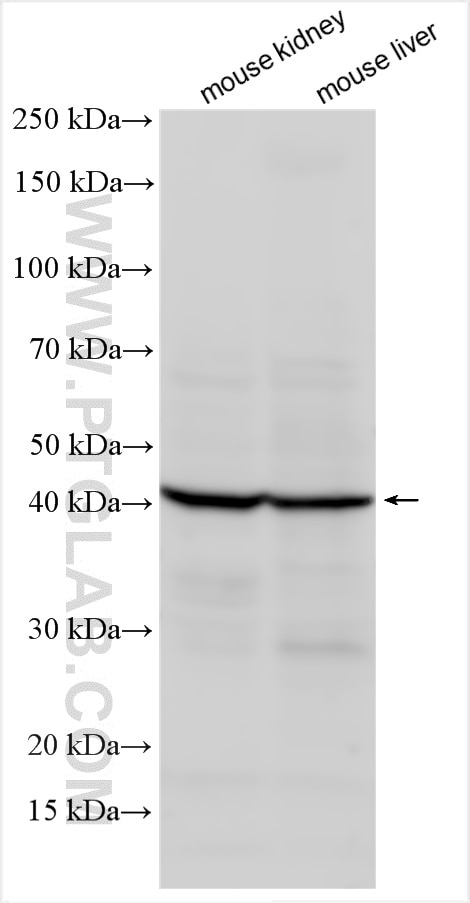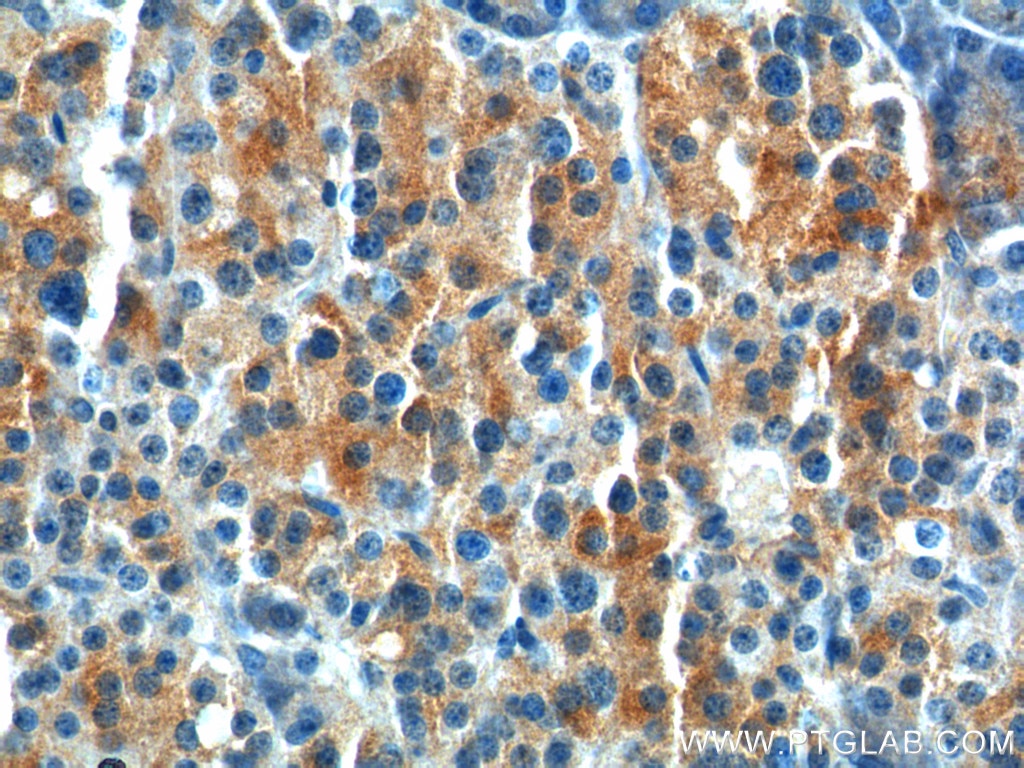- Phare
- Validé par KD/KO
Anticorps Polyclonal de lapin anti-GPR81
GPR81 Polyclonal Antibody for WB, IHC, ELISA
Hôte / Isotype
Lapin / IgG
Réactivité testée
Humain, souris et plus (1)
Applications
WB, IHC, ELISA
Conjugaison
Non conjugué
N° de cat : 20146-1-AP
Synonymes
Galerie de données de validation
Applications testées
| Résultats positifs en WB | tissu rénal de souris, tissu hépatique de souris |
| Résultats positifs en IHC | tissu pancréatique de souris, tissu de côlon humain, tissu pancréatique humain il est suggéré de démasquer l'antigène avec un tampon de TE buffer pH 9.0; (*) À défaut, 'le démasquage de l'antigène peut être 'effectué avec un tampon citrate pH 6,0. |
Dilution recommandée
| Application | Dilution |
|---|---|
| Western Blot (WB) | WB : 1:500-1:1000 |
| Immunohistochimie (IHC) | IHC : 1:250-1:1000 |
| It is recommended that this reagent should be titrated in each testing system to obtain optimal results. | |
| Sample-dependent, check data in validation data gallery | |
Applications publiées
| KD/KO | See 1 publications below |
| WB | See 3 publications below |
Informations sur le produit
20146-1-AP cible GPR81 dans les applications de WB, IHC, ELISA et montre une réactivité avec des échantillons Humain, souris
| Réactivité | Humain, souris |
| Réactivité citée | rat, souris |
| Hôte / Isotype | Lapin / IgG |
| Clonalité | Polyclonal |
| Type | Anticorps |
| Immunogène | GPR81 Protéine recombinante Ag13682 |
| Nom complet | G protein-coupled receptor 81 |
| Masse moléculaire calculée | 346 aa, 39 kDa |
| Poids moléculaire observé | 39 kDa |
| Numéro d’acquisition GenBank | BC066881 |
| Symbole du gène | GPR81 |
| Identification du gène (NCBI) | 27198 |
| Conjugaison | Non conjugué |
| Forme | Liquide |
| Méthode de purification | Purification par affinité contre l'antigène |
| Tampon de stockage | PBS avec azoture de sodium à 0,02 % et glycérol à 50 % pH 7,3 |
| Conditions de stockage | Stocker à -20°C. Stable pendant un an après l'expédition. L'aliquotage n'est pas nécessaire pour le stockage à -20oC Les 20ul contiennent 0,1% de BSA. |
Informations générales
GPR81 (G protein-coupled receptor 81) is one of a large family of GPRs with low affinity for hydroxy-carboxylic acid structure ligands (PMID: 24657625). Lactate functions as a signaling molecule by serving as an agonist for the GPR81, involving both autocrine and paracrine mechanisms (PMID: 31836453). Moreover, A higher molecular mass band (∼60 kDa) is present in the brain and adipose tissue. This band is also strong in the transfected HeLa cells but weak in native HeLa cells and is therefore probably a form of GPR81, possibly a glycosylated form of the receptor (PMID: 23696276).
Protocole
| Product Specific Protocols | |
|---|---|
| WB protocol for GPR81 antibody 20146-1-AP | Download protocol |
| IHC protocol for GPR81 antibody 20146-1-AP | Download protocol |
| Standard Protocols | |
|---|---|
| Click here to view our Standard Protocols |
Publications
| Species | Application | Title |
|---|---|---|
Life Sci Aerobic exercise regulates GPR81 signal pathway and mediates complement- microglia axis homeostasis on synaptic protection in the early stage of Alzheimer's disease | ||
Front Oncol Lactate increases tumor malignancy by promoting tumor small extracellular vesicles production via the GPR81-cAMP-PKA-HIF-1α axis
| ||
Sci Rep PET-CT and RNA sequencing reveal novel targets for acupuncture-induced lowering of blood pressure in spontaneously hypertensive rats. |








